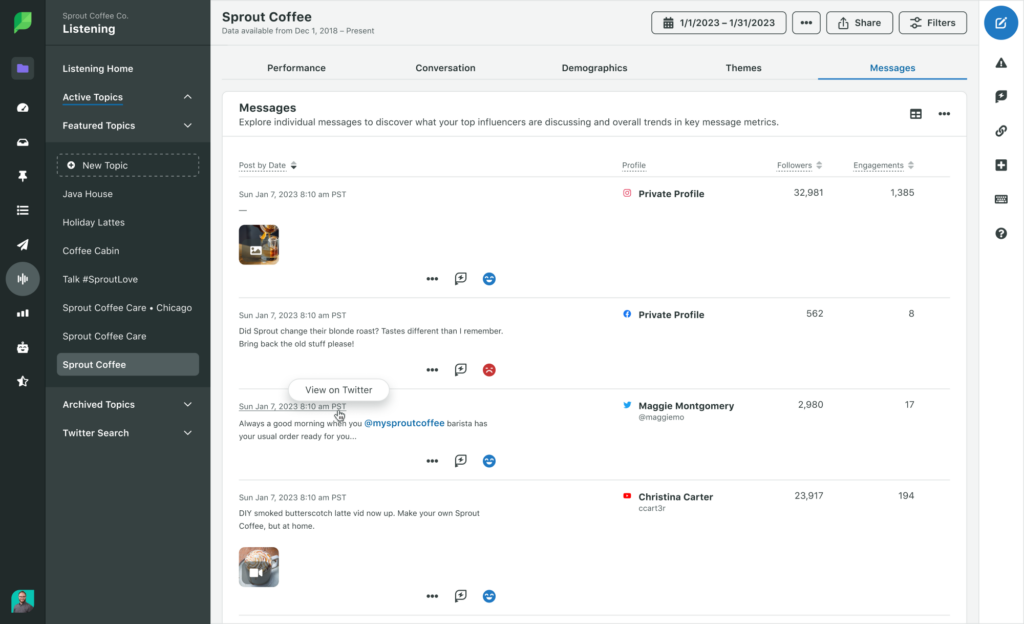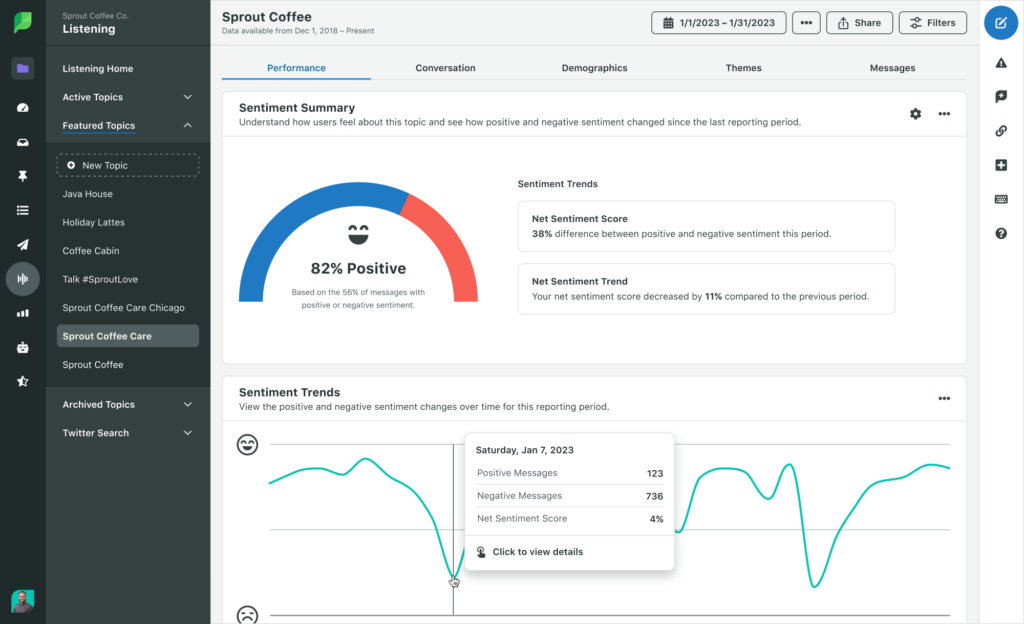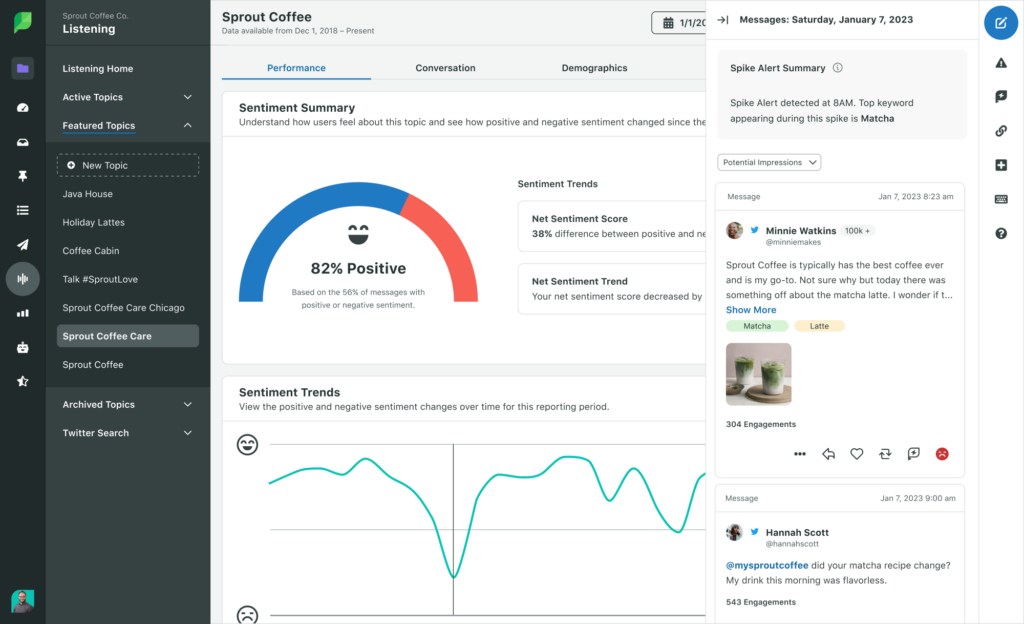Social insights that give you a glimpse into the minds of your audience are often the hardest to access by traditional means. Insights like how audiences feel, an overall response to your brand’s events or campaign, your competitor performance—these are all critical findings that require digging deeper than surface level.
And social listening can unearth these game-changing insights…if you know how to use it. Listening is like mining social data to get to the buried gold insights, so you can put social data into action.
While there’s no denying the value and power of social listening, a tool this impactful can make it feel intimidating to get started. In this article, we’ll take you through 6+ social media listening examples and the strategies real brands use to inspire you to get more from listening.
Request a personalized demo
6 social media listening examples and strategies to help you mine for insights
To start excavating deeper insights for your brand, you need to fill your toolbox with the right strategies and approaches. Check out these social media listening examples employed by other brands to start building your social listening strategy and playbook.
Find relevant and authentic influencers for partnerships
According to a Q3 Sprout Social Pulse Survey of 307 marketers, 81% of respondents say influencer marketing is an essential piece of their social strategy. And this trend is likely to continue.
Social listening can help you unearth relevant influencers to partner with. This was particularly helpful for software company Goally. Including stories of real parents and families using their products is a vital part of their social content strategy—especially on TikTok. By using Sprout’s Social Listening solution, Goally’s social team connected with relevant influencers who had a major impact on their growth.
As Goally’s Marketing Manager Kaelyn Brooks told Sprout, “During our first few influencer initiatives on TikTok, we saw the number of users on our website with intent to buy increase by about 4%.”
Listening even helped them find an influencer who connected them with an entire pool of other relevant influencers and creators.
Apply it: Half of marketers say they choose influencers who are already genuine fans of their product, according to the same Q3 2023 Sprout Pulse Survey. Social listening can help you uncover influencers who already love your products to create authentic partnerships.
Use the Messages tab in Sprout’s Social Listening interface to find relevant messages. Sort messages by the follower count of the publisher or engagements to easily find top influencers to partner and engage with.
Goally uses Sprout Social Listening to find smaller creators organically, and invites them to join their affiliate program. “It’s also helpful to make sure we’re engaging and commenting on the popular posts for brand awareness in general,” Kaelyn tells us.

Learn how people feel about your brand, products and content
To understand brand health, you must demystify how your audience feels about you and your products. This is especially important when your company makes big moves.
One computer software company uses Sprout Listening to measure sentiment around their brand and products ahead of rebranding. With Listening, they uncover keywords people use about their current brand, and the social conversation after the brand shift. This has empowered them to understand associations with their existing brand, and the impact post-rebrand in the social space.
Measuring sentiment can also help brands establish an overall baseline to answer the question, “how do people feel about us, and has that changed?” Without social listening, it’s tough to understand whether your brand sentiment has spiked or dipped. Another computer software company regularly uses listening to understand their overall brand sentiment. By doing so, they recognize when a dip or a spike in sentiment occurs, and they can dig into specific conversations to help them unpack the change.
Apply it: Be the first to know if sentiment around your brand is rising or falling. Start with a bird’s eye view—in Sprout, the Sentiment Summary presents a clear data visualization of your sentiment from conversational analytics for a chosen date range, including where dips or spikes occurred.

Then, dig in further. Get an idea of what caused spikes or dips on specific days with the sentiment summary message explorer. Click into dips or spikes on the Sentiment Trends chart to surface messages that contributed to changes in sentiment over time.

And to get granular down to the keyword level, Sprout’s Word Cloud feature visualizes the common keywords used in the conversation around the topic or topics you’re listening for. Click into any of these words to further filter them, or to explore messages that use them and their sentiment.

Find new ways to improve engagement, awareness and content
Engagement metrics on your owned content tell you what you’re getting right. But listening can inspire and inform new content that resonates.
This is especially important for brands with multiple events or locations. You won’t see every post, activation or article about the many branches of your org with basic monitoring. But social listening zooms out to surface stories and news you may have missed.
For example, a fundraising organization was struggling to source stories from the many fundraising groups, locations and events under their umbrella. They were missing opportunities to share the wider impact of their organization.
Sprout’s Listening solution provided a way for them to sort and track stories and mentions across locations and fundraising groups. They could follow specific topics and keywords and measure how much of the conversation those topics took up, engagements they drove and more.
But engagement is about more than just content: it’s about connecting with your target audience in conversations that matter most to them. Doing so can build community and brand awareness.
Listening also enables you to surface relevant conversations beyond those you’re tagged in. This can help you grow brand awareness by jumping into relevant conversations. One company in the health insurance industry makes their name known by doing exactly that—whether or not they’re mentioned. They use social listening to keep tabs on conversations surrounding health and wellness topics. This saves them time scouring the social space to source those conversations.
The result? They were able to grow their thought leadership presence and community by joining more conversations that mattered to their target audience.
Apply it: Customers often get stuck when building their listening queries. But crafting smarter queries is key to ensuring you’re getting the most impactful listening experience and unearthing conversations and stories that matter.

Here are a few tips to craft a query that sets your listener up for success:
When adding inclusions…
- Start with the basics, including the main keywords you want to listen for (think brand name, products, etc.), hashtags and X (formerly known as Twitter) handles that are important to you.
- Add alternate spellings, grammatical errors and misspellings of your brand and product names.
- Think about other social handles and hashtags to include that people may mention next to your own.
- Add your website links.
When adding exclusions…
- Use the Topic Preview—this will show you any unwanted content and noise in the conversation and can guide exclusions to filter your results.
- Find and exclude any social handles that are adding to the noise.
- Lean on pre-built noise exclusion options.

Identify potential crises and track sentiment for negative spikes
Detecting potential brand crises early is one of the primary use cases for social listening. By monitoring negative chatter, sentiment shifts and spikes in specific topics, teams can detect conversation shifts early and prepare a response more proactively.
This is especially important for highly regulated industries. For example, one company uses listening as part of their financial services risk mitigation strategy after they experienced a data incident. While the incident was not recent, executives wanted to monitor conversations around it. So the team set up their listening solution to track conversations around relevant keywords—think: “breach” and “litigation.” This way, they keep their finger on the pulse of the conversation, and they’re the first to know if the story picks up traction again.
While one company uses listening to stay proactive, another used listening to keep tabs on an ongoing industry crisis for their clients. An agency in the building and manufacturing industry had a client that was impacted by COVID-caused product delays. They used listening to follow the digital conversation around the supply chain crisis, to understand how consumers were reacting and to inform how they should navigate the chatter.
Conversations like these could easily go undetected if teams relied only on mentions. With listening, they can keep their finger on the pulse of the conversation, guide their response and detect crucial shifts.
Apply it: Use some of the methods we’ve talked about in these social media listening examples so far to listen for keywords and monitor sentiment and conversations that keep you ahead of brand crises.
Get intel to stay ahead of the competition
As the revised old saying goes: keep your friends close, and your competitors closer. To stay ahead, you need to keep one eye on what you’re doing and another on what competitors are doing—which social listening does within seconds.
One agency uses social listening to create smarter pitches against competitors. Using social listening, they’ll look into new services their competitors offer, and new clients they boast. As a result, they head into pitches more informed and can find the best ways to differentiate their offerings.
Using Sprout’s Competitive Listening topic can inform your content strategy through competitor content. One company in the gaming industry uses Listening to monitor top competitor content and digital chatter. Doing this inspires fresh content that resonates with relevant audiences and empowers them to keep an eye on competitor performance compared to theirs.
Apply it: Use social listening to get a high-level grasp on your competitors’ engagement metrics and your share of voice next to theirs. Then, zoom into their social content to help inform your own.

And pro tip: Don’t sleep on the Sprout Listening Themes feature–it will help you during competitor analysis and beyond. They’re like a Listening topic nested within your larger topic to help you organize your query by specific categories. You can even compare themes against each other.
This is helpful if you’re asked for specific product feedback or event reactions. For example, let’s say you’re a coffee company and you’re using the Brand Health Listening template in Sprout. You notice a lot of your incoming messages focus on drink types, and you want to see how your audience talks about, say, your seasonal drinks vs. your mainstays.
You don’t have to create a whole new listening topic—you just need to add Topic Themes to compare these message types. Go to your Listening Query, scroll down, select Add Themes (Optional) and build your theme much like you built your initial Listening query.

This can also help you understand the conversation around a theme across your brand and competitors. Here’s how Themes might look for a University comparing notes in a Competitor Analysis template.

Finally, listening also enables you to find engagement spikes on competitor channels. With the Competitor Engagements graph, click into specific engagement spikes to see what drove the conversation. What did they post about? Is it a trend you should join in on? A new offering, product or announcement you should be aware of?

Perform market research to inform teams beyond marketing
Sharing insights from your social media data collection beyond the marketing team is becoming a more common, and needed, practice. Today, 76% of marketers agree their team’s social insights inform other departments, according to The 2023 Sprout Social Index™.
From competitive intelligence to product learnings, social listening insights are often bigger than social. And the brands using social insights to enrich business decisions beyond the social team are working and growing smarter.

For example, one agency in the building and manufacturing industry uses listening to keep their product team one step ahead. They set up five different listening topics about new products they had plans to eventually develop and offer. Keeping tabs on these product types in the conversation helped them uncover gaps in the industry, learn how people feel about the different product types and see what their competition looked like.
This product knowledge isn’t always the most impactful for social or content. But it’s invaluable for product planning and the decision-making that goes into it.
Apply it: Using some of the tactical listening tips we’ve discussed, mirror this brand. Set up Listening topics in Sprout around specific products. Analyzing the conversation and sentiment around these products enables you to understand how people feel about them, gaps you can fill, pain points and what makes competitor products stand out.
Use these social media listening examples to unearth social insight gold
With these social media listening examples in the back of your mind, what gems will you discover that can change your strategy and entire business?
If you’re already a Sprout customer, don’t hesitate to reach out to us if you need more help. And if you don’t have Sprout’s Listening solution yet, reach out to us for a free demo to explore social listening for yourself.
Request a personalized demo